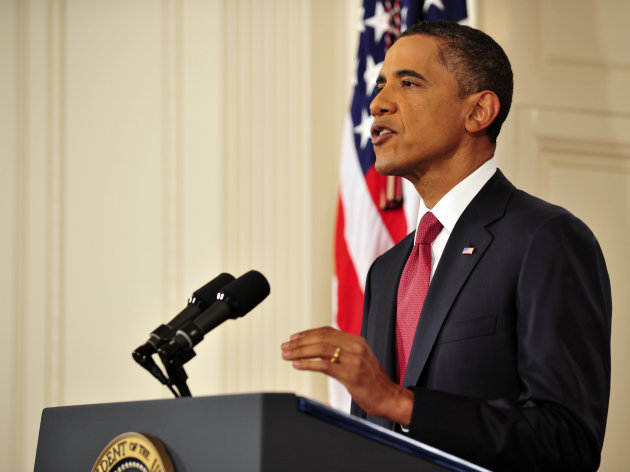As the clock ticks down toward a possible default on US debt, President Obama’s leadership style is coming under increasing scrutiny.
In recent weeks, Mr. Obama has relied heavily on the bully pulpit – press conferences, televised statements, speeches – to push for a bipartisan compromise that would enact major deficit reduction in exchange for an increase in the federal debt ceiling. The Treasury Department says the US risks beginning to default, with calamitous economic results, if no action is taken by Aug. 2.
But no amount of public jawboning by the president is going to move opinion on Capitol Hill, especially among the newly elected House hard-liners from the conservative tea party movement. Even as Obama’s call Monday night for citizens to contact their members of Congress over the crisis led to downed websites and jammed phone lines, a solution looks as distant as ever.
RECOMMENDED: Five ways US default would hit your pocketbook
And Obama himself is no longer even a direct party to the negotiations. His White House must rely on its Democratic allies, particularly in the Democratically-controlled Senate, to stay in the loop.
Obama’s predicament is not entirely of his own making. Hyper-partisan gridlock has been years in the making. And the challenges faced by House Speaker John Boehner, who has effectively boxed himself in trying to satisfy his most conservative Republican Party members, have added to Obama’s woes.
But certainly there is a dimension to Obama’s leadership style – a tendency to set a policy framework and then let Congress work out the details – that has contributed to the state of play.
He followed that modus operandi with both the big economic stimulus package early in his term, and then health-care reform, but then Democrats had majorities in both houses of Congress. He could safely assume they’d pass legislation he could sign. Now the game is different: He faces a balky Republican majority in Congress.
“He’s clearly a president who accepts the terms of debate and then tries to work from within that,” says Julian Zelizer, a presidential historian at Princeton University in New Jersey. “He’s not a president who tries to shape the agenda, who tries to tell Americans how they should be thinking about problems.”
In effect, Obama allowed House Republicans to refocus American politics onto deficit reduction, and allowed them to tie spending reduction to the debt ceiling without weighing in forcefully with an alternative vision. Last December, he didn’t embrace the recommendations of his own bipartisan deficit reduction commission, and in his State of the Union address in January, he again avoided any serious discussion of how to address the looming deficit crisis.
“A lot of my criticism [of Obama] is based on the idea that dealing with this problem required educating the public and building support for what I think is a centrist solution over time,” says David Schanzer, a professor of public policy at Duke University in North Carolina.
Still, he credits Obama for demonstrating flexibility and a willingness to take on his own party over entitlement reform.
“What we’re really seeing now is very weak leadership in the House and exceptional intransigence,” says Mr. Schanzer.
IN PICTURES: Who's who in the US debt crisisOne of the criticisms among Republicans is that Obama has yet to put out his own detailed plan for deficit reduction. But, Schanzer points out, after the Democrats’ shellacking in the midterms – in part over health-care reform – Obama was hardly going to set himself up for another public pounding so soon by showing his hand on entitlement reform.
Still, he says, the release of the Ryan plan – a Republican budget proposal by House Budget Chairman Paul Ryan calling for wholesale entitlement reform –was Obama’s cue to educate the public on how he would resolve the deficit crisis.
Fast forward to today. Thomas Mann, a senior fellow at the Brookings Institution, sees Boehner as a “prisoner” of his party caucus.
“Obama nonetheless chose to negotiate with him, but now realizes he will have to force a solution that is opposed by a majority of House Republicans,” Mr. Mann says. “His effort to deal with Boehner improved his position with the public; now the test is whether he stands strong or caves.”
Other, more risky leadership options for Obama lurk in the background. One centers on Section 4 of the 14th Amendment of the Constitution, which states that the “the validity of the public debt of the United States ... shall not be questioned.”
On Wednesday, House Democratic leaders urged Obama to invoke the 14th Amendment and unilaterally raise the debt ceiling if Congress can’t reach agreement by Aug. 2. Obama recently said that he has discussed the idea with his counsel, and been advised not to pursue that route.
Another alternative, as laid out by two law professors in The New York Times on July 22, would be to invoke overall constitutional authority as president to raise the debt ceiling, in the name of preventing a national catastrophe. Obama could look to his idol, President Lincoln, as his role model.
“When Abraham Lincoln suspended habeas corpus during the Civil War, he said that it was necessary to violate one law, lest all the laws but one fall into ruin,” wrote Eric Posner and Adrian Vermeule.
Either constitutional move would be highly risky. At a Latino civil rights convention on Monday, Obama mused on the idea of bypassing Congress and changing the laws on his own – explicitly on immigration and, by implication, on the debt ceiling.
“Believe me, the idea of doing things on my own is very tempting,” he said. But “that’s not how our democracy functions.”
And given Obama’s usually cautious style, it would hardly be in character for him to throw up his hands and bypass Congress altogether, without permission.
RECOMMENDED: Five ways US default would hit your pocketbook



No comments:
Post a Comment